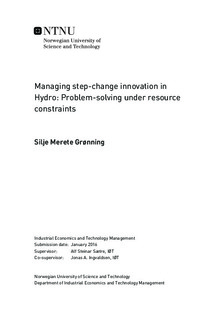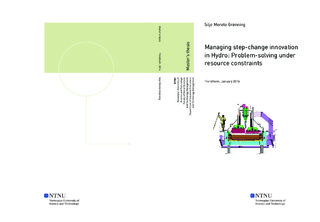| dc.description.abstract | The purpose of this thesis is to create the beginning of a theory of how to manage step-change innovation projects in process industries. Drawing on well-established definitions of different innovation types I present the concept of step-change innovation, which I define as: The practical implementation of an idea, outside the current technological trajectory, leading to changes of the concepts in a production process , and relate it to process innovation initiatives. I raise the following research questions:
RQ1: How are step-change innovation projects initiated in the process industry? Hereunder, what are the key issues or elements and how are they managed?
RQ2: How are step-change innovation projects implemented in the process industry? Hereunder, what are the key issues or elements and how are they managed?
Based on key lessons learned from three case studies within Hydro, I say something about what is best practice for managing step-change innovation in the process industry. Altogether 28 informants were interviewed, and although there are limitations to this study, I find the empirical evidence grounding the findings to be strong. The first step-change innovation project concerns the implementation of a new process technology in the wire rod cast house at Hydro s plant in Karmøy. The second case is a step-change innovation project conducted in the Sunndal Carbon unit at Hydro`s plant in Sunndalsøra, and the third case investigated is a pilot project of the Adjustable Flexible Moulds (AFM) casting technology conducted in Høyanger.
Systematic problem-solving, external expertise and support of local management characterized the initiation of the step-change innovation projects. The possibilities for the production units to maintain the flexibility required for conducting ambiguous innovation projects were found to be constrained by daily tasks and continuous production within the unit. It was identified a pattern of new problems emerging when realigning the new technology with the existing machinery. The conceptual model for managing step-change innovation presented in this thesis, illustrates the advantages of having project managers on-site, devoting sufficient time to the project and working in a partnership with the production unit throughout the innovation process. | |

